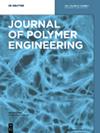木质素基复合膜吸附H2S的动力学和热力学研究
IF 1.7
4区 工程技术
Q4 POLYMER SCIENCE
引用次数: 0
摘要
摘要采用溶液浇铸法制备了两种木质素基复合膜,分别命名为Cu-CLA/PVA和CuO-LA/PVA/CNF。利用吸附模型对复合膜除臭过程进行了动力学和热力学分析。结果表明,两种膜对H2S均有良好的吸附性能,吸附量为36.39 毫克 g−1和35.69 毫克 g−1。吸附过程主要遵循拟二次动力学模型、颗粒内扩散模型和Freundlich等温吸附模型,表明颗粒内扩散阻力控制了H2S的吸附速率,H2S通过多层吸附在膜的非均匀表面。Cu-CLA/PVA对H2S的吸附是一个放热过程,而CuO-LA/PVA/CNF对H2S的吸收是一个吸热过程,表明Cu-CLA/PVA在低温下更适合吸附H2S,但CuO-LA/PVA/CNF在高温下有利于H2S的吸附反应。△G对Cu-CLA/PVA和CuO-LA/PVA/CNF都是负的,表明Cu-CLA/PVA和CuO-LA/PVA-CNF对H2S的吸附都是自发的。本文章由计算机程序翻译,如有差异,请以英文原文为准。
Kinetic and thermodynamic studies of H2S adsorption by lignin-based composite membranes
Abstract Two lignin-based composite films were prepared by solution casting, which were named Cu-CLA/PVA and CuO-LA/PVA/CNF, respectively. The kinetic and thermodynamic analyses of the deodorization process of the composite membranes were performed by using adsorption models. The results showed that both membranes had good adsorption performance for H2S with the adsorption amounts of 36.39 mg g−1 and 35.69 mg g−1, respectively. The adsorption processes were mainly following the pseudo-secondary kinetic model, intraparticle diffusion model, and Freundlich isothermal adsorption model, indicating that the intraparticle diffusion resistance controlled the H2S adsorption rate and H2S was adsorbed on the non-homogeneous surface of the membranes through multiple layers. The adsorption of H2S by Cu-CLA/PVA is an exothermic process, while the adsorption of H2S by CuO-LA/PVA/CNF is a heat-absorbing process, indicating that Cu-CLA/PVA is more suitable for H2S adsorption at low temperatures, but CuO-LA/PVA/CNF, at higher temperatures, is favorable for H2S adsorption reactions. △G is negative of both Cu-CLA/PVA and CuO-LA/PVA/CNF, indicating that both Cu-CLA/PVA and CuO-LA/PVA/CNF are spontaneous for H2S adsorption.
求助全文
通过发布文献求助,成功后即可免费获取论文全文。
去求助
来源期刊

Journal of Polymer Engineering
工程技术-高分子科学
CiteScore
3.20
自引率
5.00%
发文量
95
审稿时长
2.5 months
期刊介绍:
Journal of Polymer Engineering publishes reviews, original basic and applied research contributions as well as recent technological developments in polymer engineering. Polymer engineering is a strongly interdisciplinary field and papers published by the journal may span areas such as polymer physics, polymer processing and engineering of polymer-based materials and their applications. The editors and the publisher are committed to high quality standards and rapid handling of the peer review and publication processes.
 求助内容:
求助内容: 应助结果提醒方式:
应助结果提醒方式:


